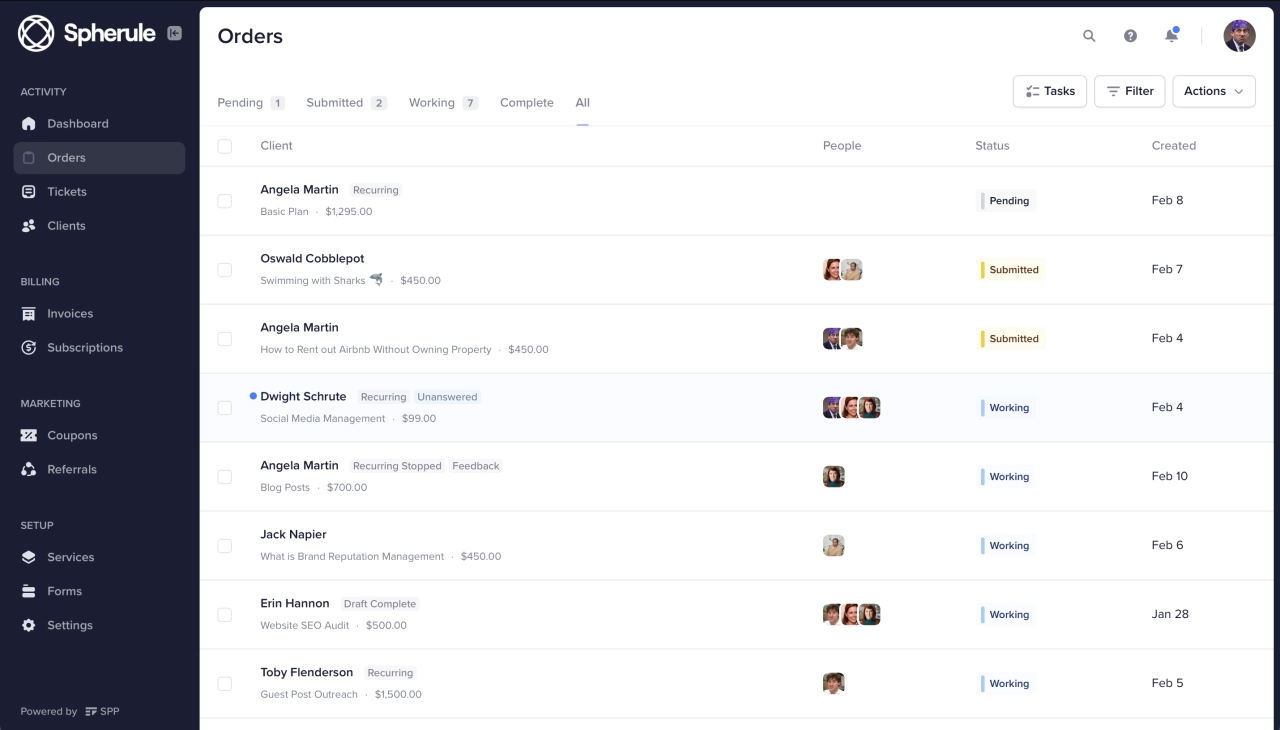- 3 mistakes are nearly impossible to recover from (market validation, pricing models, cash flow), so get these right before worrying about the five fixable operational issues.
- Productization requires fundamentally different thinking than custom services—you’re rebuilding delivery systems, financial planning, and client expectations, not just changing your pricing page.
- The agencies that successfully productize anticipate what breaks at scale and build prevention systems upfront rather than learning these lessons at $91,000 per mistake.
You’ve done your homework on productization. You understand the promise: predictable revenue, better margins, escaping the billable hour trap. The concept clicks. So why does that quiet voice in your head keep asking, “Yeah, but what am I missing?”
That voice isn’t doubt—it’s experience. You’ve run a service business long enough to know the gap between great idea and profitable reality gets filled with operational details most guides skip.
Here’s what the data shows: Predictable Profits analyzed 300+ agencies in 2025 and found that while 74% grew their revenue, the ones maintaining 25–32% profit margins did something the 18-22% margin agencies didn’t. They anticipated the operational realities before launch, not after.
This guide walks through the 8 most expensive challenges agencies face when productizing. We’re talking real numbers—what scope creep actually costs, why underpricing by even 20% can sink your model, how tool chaos eats 15–20 hours per week.
Three mistakes kill productized services: misjudging market need, underpricing below viable margins, and cash flow gaps that force you to cut your own salary. The other five hurt, but you can recover. Here’s what to watch for and how to prevent each one.
Understanding this topic involves several interconnected concepts:
Each of these concepts plays a crucial role in the overall topic.
Understanding the risk landscape
Productization overhauls your entire delivery system. You’re not just changing pricing—you’re rebuilding how you onboard, deliver, communicate, and scale. Most agencies hit their roughest patch during months 3–6, when delivery at scale reveals what your systems can’t handle.
Before we dig into specific pitfalls, a quick gut check: if you’re still weighing whether productization makes sense for your agency, start with my guide on when to productize your service. This post assumes you’ve already made that decision—now we’re focused on making sure the transition doesn’t cost you $50,000+ in avoidable mistakes. The mistakes that sink productized services fall into four categories:
Risk Category | Impact Zone | Financial Stakes | Time to Detect | What This Means |
|---|---|---|---|---|
Market & Positioning | Customer acquisition, competitive differentiation | Wasted development time, poor product-market fit | 3–6 months | Building what nobody wants. Skip validation, productize your passion project instead of client pain, and you’ll spend months selling something the market doesn’t urgently need. |
Operational & Delivery | Service delivery consistency, team efficiency | Margin erosion, operational chaos | 1–3 months | Customization creep destroys standardization. Manual onboarding becomes a bottleneck. The difference between 28 billable hours per week and 32 comes down to systems that scale versus ones that don’t. |
Financial | Cash flow, pricing strategy | Revenue gaps, underpricing | Immediate to 6 months | Pricing that can’t cover true costs even when everything goes perfectly. Cash flow valleys during transitions force you to cut your own salary. Some agencies discover their model mathematically can’t hit target margins—Marcel Petitpas at Parakeeto sees this repeatedly. |
Client & Legal | Client relationships, contractual obligations | Lost revenue, legal disputes | Immediate to ongoing | Clients expect unlimited revisions on fixed-price packages. Missing contracts cost $50,000+ when disputes hit. Mediation averages $7,000. Litigation runs $91,000 and takes 1–3 years. |
With that said, knowing the categories isn’t enough—you need to know when each problem surfaces. Some mistakes reveal themselves immediately at launch. Others take months to detect, by which point they’re expensive to fix. The timeline below shows when to watch for each pitfall:
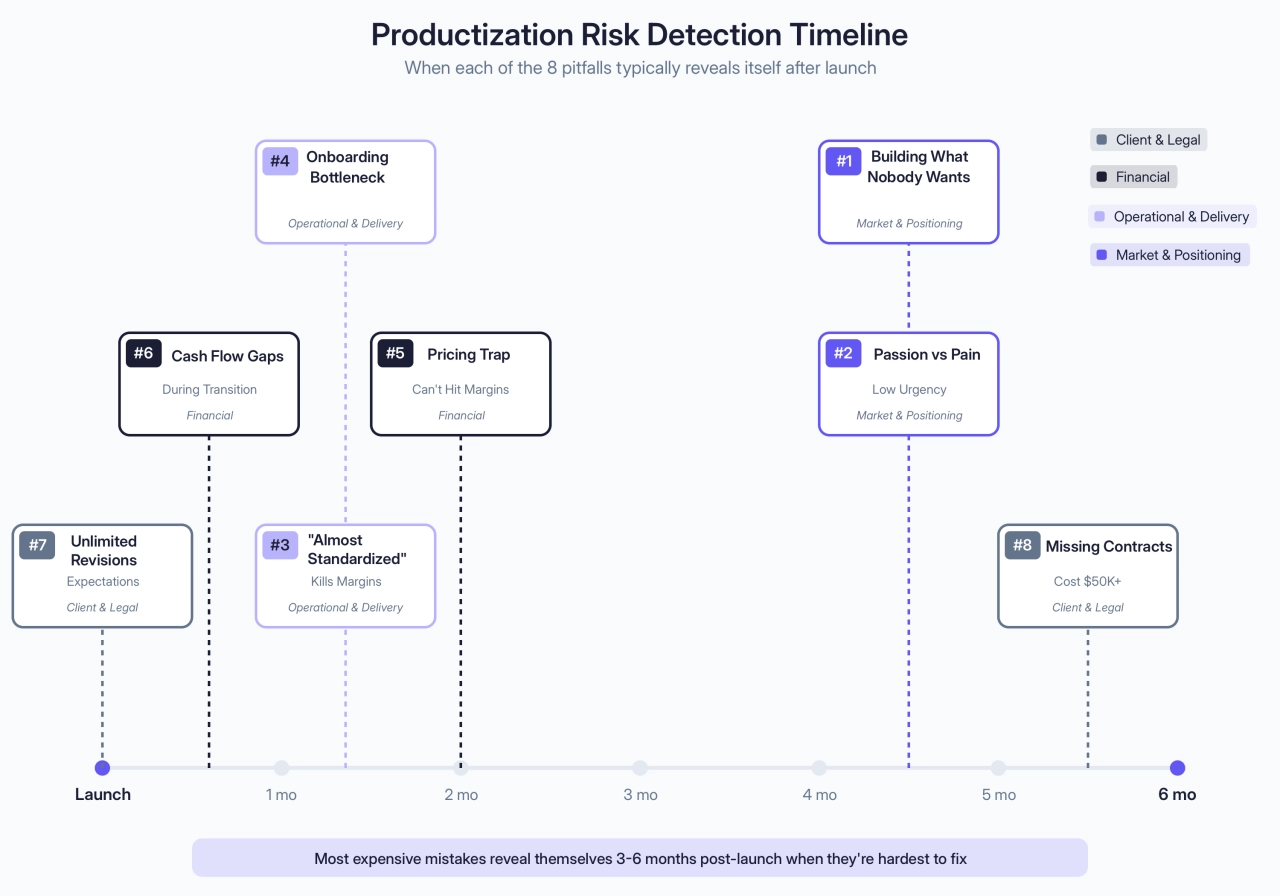
Market & positioning challenges
Market mistakes happen before launch and cost the most to fix. You build something nobody wants, realize it six months in, and eat $15,000 to $30,000 in sunk costs you’ll never recover.
Pitfall #1: building what nobody wants
This is productizing what’s easy for you instead of what’s valuable to them. You love technical SEO audits, so you build a $5,000 productized package. The problem? Your market wanted $500 quick fixes or $20,000 comprehensive strategies. Your price point sat in a dead zone nobody was shopping in.
Business impact: Development costs alone run $15,000–$30,000 when you factor in the time spent building systems, creating templates, and setting up processes. Add 3–6 months of opportunity cost—the revenue you could have earned doing client work—and you’re looking at $50,000+ in total impact. Then there’s the reputation risk of launching something that flops publicly.
Real example from Tyler Sprunk (Forgelight Creative): Tyler and his co-founders started their marketing agency right out of college. Like many new agency owners, they knew they should pick a niche—but they weren’t sure which one.
Their solution? “So, we decided that in the first couple of years we would just take whatever projects we could get from just about anyone. Then, we thought, over time we would discover the types of projects and clients we were best at and pick those as our niche.”
The theory sounded great, but the reality looked quite different.
Anyone who has done outbound sales knows how difficult it is if you don’t have a good idea of who you should be reaching out to.
 Tyler Sprunk,
Forgelight Creative
Tyler Sprunk,
Forgelight Creative
Without a clear niche:
they couldn’t build a consistent sales message
outbound prospecting was nearly impossible (who do you even call?)
they couldn’t develop specialized expertise
every client required custom solutions
word-of-mouth referrals were scattershot
After three years of struggling with these fundamental issues—combined with other operational problems—Forgelight closed its doors. Tyler reflects: “If I were to start a new agency today, I would spend significant time picking a niche and then hold ourselves to that niche religiously.”
How to prevent this: Run a validation pilot before building anything. Sell 3–5 beta versions at 50% discount to prove demand with minimal investment. This validates the market wants it without requiring you to build full systems first.
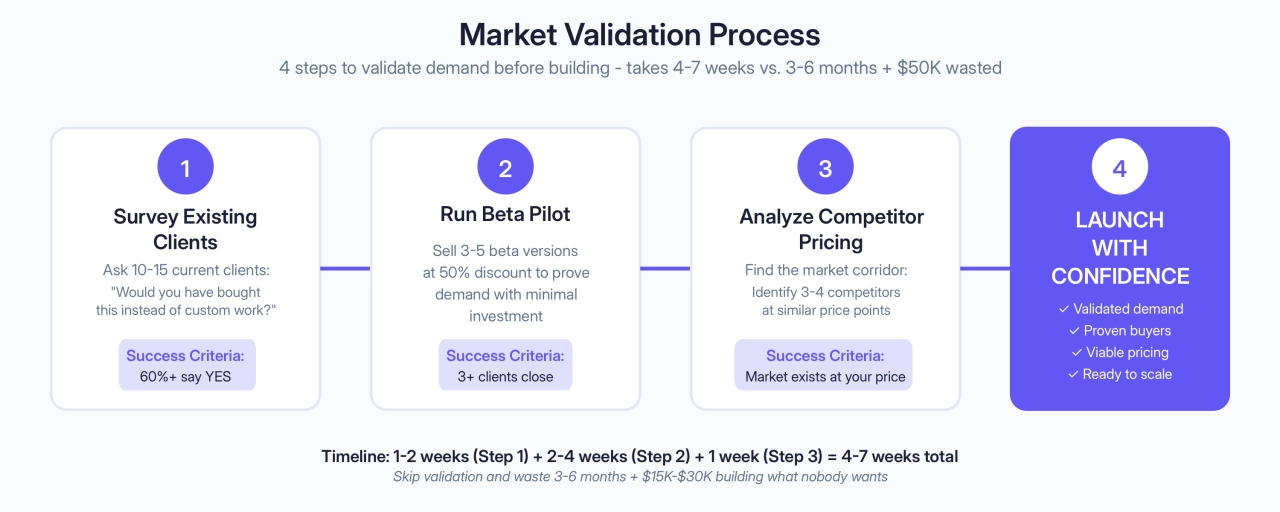
Survey your existing clients with one specific question: “Would you have bought this instead of custom work?” You need 60%+ saying yes before proceeding. Anything less means you’re guessing.
Analyze competitor pricing to find the market corridor. If you can’t find 3–4 competitors at similar price points, you might be creating a market that doesn’t exist—which is expensive and risky. Looking at proven productized service examples across industries can help you understand what validated models actually look like.
Pitfall #2: productizing your passion instead of client pain
You’re brilliant at technical SEO audits and love doing them. So you build an $8,000 Comprehensive Technical SEO Audit package. One problem: your prospects see technical SEO as optional maintenance, not an urgent business priority. You’ve built a vitamin when they need aspirin.
Business impact: Low conversion rates below 5% despite quality service. You spend months perfecting an offer nobody’s urgently buying. Constant client education is required—expensive and exhausting. When prospects view your service as nice to have instead of must have, you’re fighting an uphill battle every single sale.
Real example from Tom Whatley (Grizzle): Tom launched Grizzle in 2016 as a productized digital PR service. He loved the work, had deep expertise in it, and saw a clear market opportunity. He built systems, created templates, and got his first client within two weeks. By 45 days, he had four clients signed.
Success, right?
Churn rate was high for a service that many organizations saw as a ’nice to have.’ I knew we needed to change things up to survive.
 Tom Whatley,
Grizzle
Tom Whatley,
Grizzle
The problem wasn’t execution—Tom delivered quality work. The problem was urgency. Digital PR was his passion and expertise, but it wasn’t urgent enough for clients to prioritize consistently. Marketing leaders would sign up, then deprioritize the service when budgets tightened or other fires needed fighting. Tom was building a vitamin when clients needed aspirin.
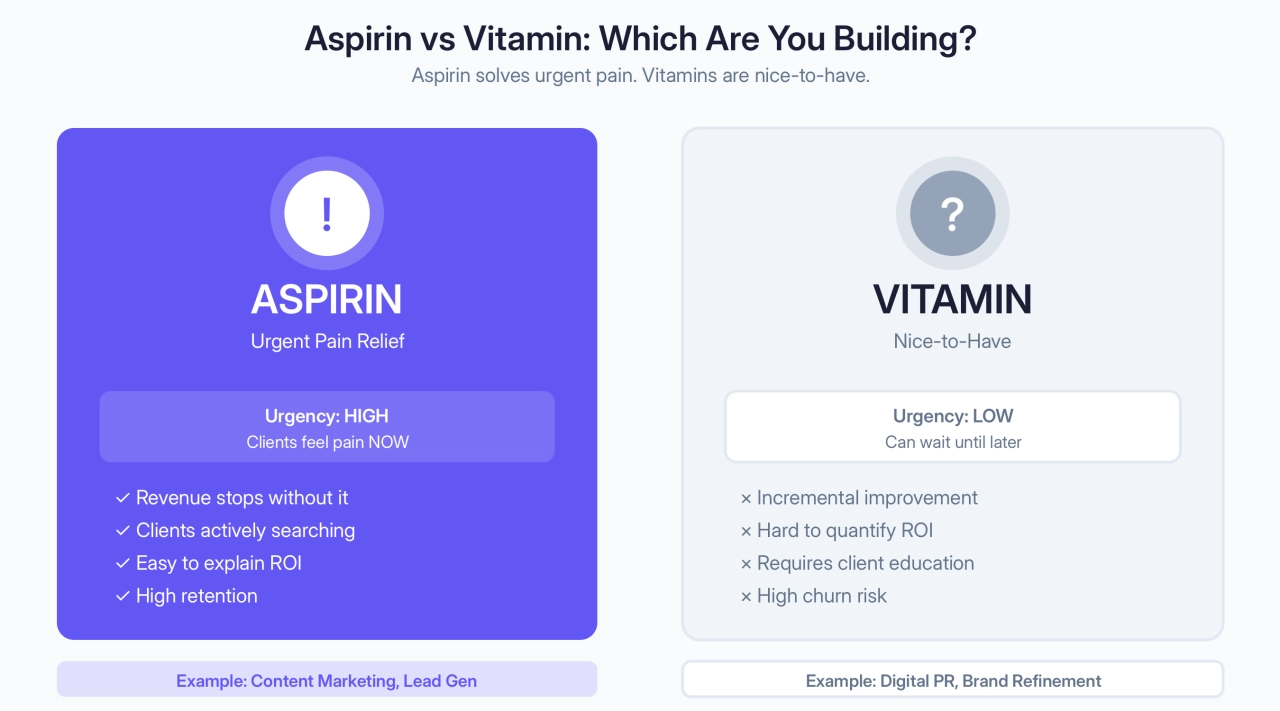
About 18 months in, facing high churn and unsustainable growth, Tom started asking existing clients a critical question: “What else are you struggling with at the moment?”
The answer that kept coming up: “Getting high-quality blog content delivered consistently.”
Tom realized: “We already did this as part of our digital PR offering and had already cemented trust.” The difference? Clients urgently needed content—not as a nice-to-have, but as a critical business function they struggled to solve internally. Content production was foundational to their marketing strategy, not optional.
Grizzle pivoted to become an SEO-focused content marketing agency. The shift in client retention was dramatic. Today, Grizzle is a full-service content marketing and SEO agency serving B2B and SaaS companies—built on solving urgent pain points, not delivering passion projects.
How to prevent this: Identify the expensive problem you solve, not the deliverable you create. Don’t say “We create beautiful designs.” Say “We reduce cart abandonment by 30% with conversion-focused design.” Frame everything in terms of revenue gained or costs avoided—specific numbers matter.
Use the urgency test: If prospects aren’t feeling pain right now, you’ll struggle to close deals.
Ask existing clients about their urgent problems, not their wish lists. Tom’s pivot came from asking “What else are you struggling with?” not “What other services would be cool?” Listen for frustration and urgency in their answers—that’s where viable productized services live. Once you’ve identified that pain point, turning it into a productized service follows a repeatable 7-step process.
Operational & delivery challenges
Operational mistakes reveal themselves during delivery, when they’re expensive to fix. Operational chaos destroys margins faster than bad pricing. The difference between agencies at 28 billable hours per week and those at 32? Systems. Get this wrong and you’ll see 15–30% margin erosion through pure inefficiency.
Pitfall #3: “almost standardized” kills margins
You start with a standardized process. First client asks for just one small change. You say yes because you want the sale. Six months later, you have eight clients with eight completely different processes. Standardization has quietly died, taking your margins with it.
Business impact: Delivery time increases 40–60% per project once customization creeps in. Team confusion and error rates spike. You can’t hire or train new people effectively because there’s no consistent process to teach. You’ve lost the entire point of productization.
Real example from Dav Nash (Fat Joe): An SEO agency launched what they called a Standard Monthly Packageat $2,000 per month. The original scope was clear: 5 specific tasks taking an average of 10 hours per month to deliver.
Then the first client asked, “Can you also do monthly competitor analysis?”
The agency said yes—and to stay fair to all clients, they added competitor analysis to everyone’s package. No price increase.
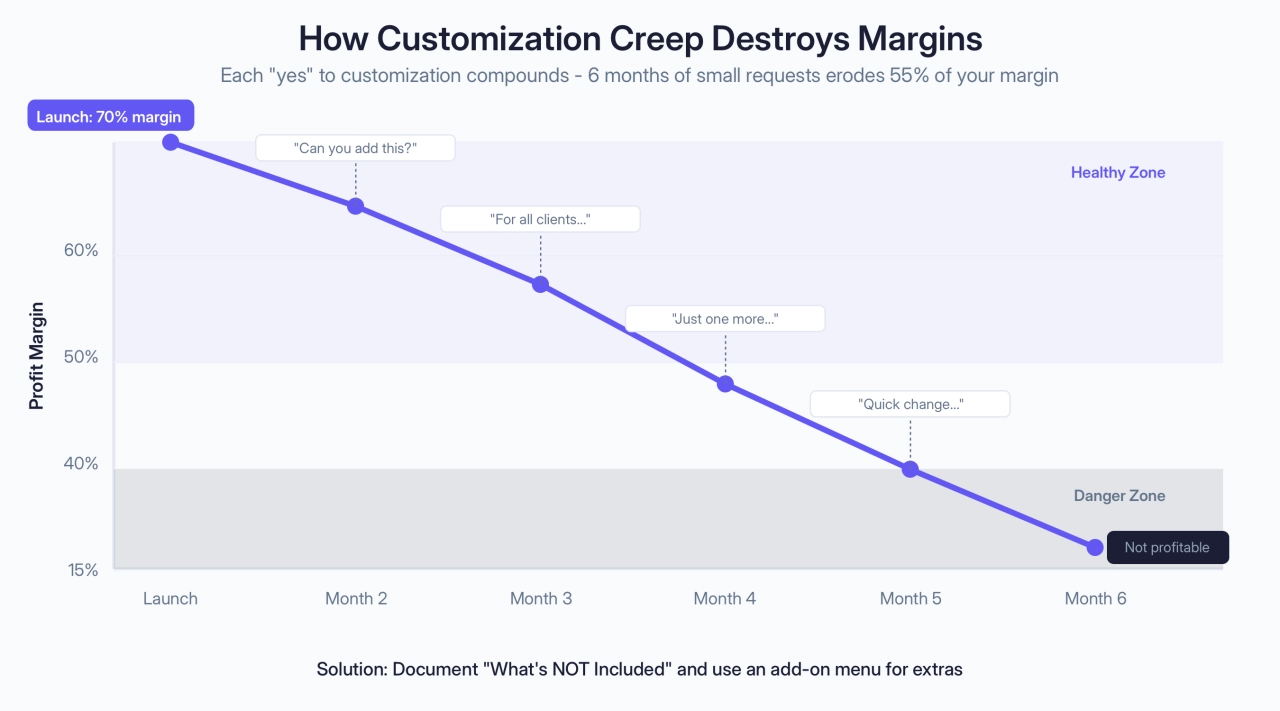
Six months later, that standard package had grown to 9 tasks requiring 18 hours of work per month. Still priced at $2,000.
Do the math: The effective hourly rate dropped from $200/hour to $111/hour. Their margin went from 70% to about 15%. Multiply that across 20 clients monthly and they lost over $50,000 annually in margin erosion—just from not saying no to one seemingly reasonable request.
How to prevent this: Create a “What’s not included” section as prominent as “What’s Included” on your sales page. List the most common out-of-scope requests clients typically make. This sets boundaries upfront and prevents 60–70% of scope creep issues before they start.
Use an add-on menu strategy. When clients want something extra, don’t just say no—offer it as a standardized add-on. Competitor Analysis: +$500/month. This gives flexibility without breaking your core system.
Implement the 3-strikes documentation rule. If three clients ask for the same customization, evaluate adding it to the standard package. If only 1–2 clients want it, it stays as an add-on or you decline. This prevents random feature creep while catching true market signals.
These boundaries become even more critical as you scale. My quality framework for scaling productized servicesshows how to maintain consistency across 20, 50, or 100+ clients without letting standards slip.
Pitfall #4: manual onboarding becomes a bottleneck
Every new client requires a 90-minute kickoff call. You ask for the same information manually every single time. Your designer sits idle waiting for the client to email over the logo files. Projects get delayed 1–2 weeks because clients forget to send login credentials—meanwhile, you’ve already charged them and the clock is ticking.
Business impact: The onboarding bottleneck limits growth to 4–6 new clients per month maximum. Each client requires 6–10 hours of back-and-forth communication before work can even start. Projects delay an average of 1–2 weeks, which wastes 15–30% of your capacity. Clients get frustrated asking, “Why is this taking so long?”
Real example from Travis Halff (Y’all): Travis founded Y’all, a marketing agency that specializes in paid social and Google ads for clients. Like most agencies, Y’all faced the classic onboarding challenge: getting access to client accounts so work could actually begin.
Nothing sets the tone of a client kickoff quite like 15 back-and-forth emails over granting access to Meta and Google ads.
 Travis Halff,
Y’all
Travis Halff,
Y’all
The core issue: manual access requests created chaos that clients interpreted as incompetence. Here’s what was happening:
15+ back-and-forth emails just to get account access
clients didn’t know which team member had admin rights
login credentials went missing or were sent to wrong email addresses
projects couldn’t start for 1–2 weeks while chasing access
first impression: disorganized and unprofessional
For Y’all, this wasn’t just frustrating—it was actively damaging new client relationships before any work had even started. As Travis notes, “Clients don’t care if the platforms are confusing—they only see an agency that looks disorganized.”
After implementing Leadsie’s automated access request system, Y’all transformed their onboarding:
access requests went from 15 emails to one secure link
onboarding time dropped from 1–2 weeks to approximately 5 minutes
clients now compliment the smooth process
Travis now showcases this in pitches: “We got a compliment recently on how ’cool that tool was’ and how it took them max five minutes to onboard us. I even show it in pitches now. It’s a great way to prove that we make life easier for clients, not harder.”
How to prevent this: Build comprehensive intake forms that collect everything upfront in one submission. Include file upload fields for logos, brand guidelines, and any assets you need. This reduces back-and-forth from 8–12 emails down to 1–2.
The challenge is getting these pieces to work together. Intake forms should feed directly into your project management; access grants should trigger delivery workflows. How you structure your stack determines whether onboarding feels seamless or becomes its own source of friction.
Implement project gates: Work doesn’t start until all intake information is received. Communicate clearly: “Your project begins 24 hours after you submit the complete intake form.” This puts the responsibility on clients to provide complete information and eliminates the back-and-forth.
Automate access requests for marketing platforms. Tools like Leadsie consolidate access requests for Facebook, Instagram, Google, TikTok, and other platforms into one secure link. What used to take 15 emails and 1–2 weeks now happens in minutes—and clients see you as professional and organized from day one.
Financial challenges
Financial mistakes kill productized services slowly, then suddenly. You’re busy, clients seem happy, then you check your numbers and realize you’ve been losing money for six months. Marcel Petitpas at Parakeeto has seen agencies discover their business model mathematically can’t hit profit targets—even with perfect execution.
Pitfall #5: pricing that can’t hit target margins
You price based on what feels competitive or what you think the market will bear. You charge $2,000 per month for a service that takes 20 hours to deliver. Looks profitable—until you factor in project management, client communication, revisions, and all the indirect time. Your actual cost? $2,400. You’re losing $400 on every single client.
Business impact: Marcel Petitpas, CEO of Parakeeto, has seen this pattern repeatedly: “I’ve run into firms where they were working so hard and trying to do everything right, managing scopes of work and delivering things on time and really managing their costs. And yet they were always struggling with profitability. We’d build a model of their firm and realize: if everything goes perfectly, you’ll only make 14% net profit when you wanted 20%. It’s literally impossible for you to achieve your goals with the business designed this way.”
The data backs this up. Agencies at 18–22% margins typically underpriced from day one. Those at 25–32% margins? They built proper cost models before setting prices.
Real example from Ilija Brajković (Kontra Agency): Ilija discovered this trap the hard way. His agency had maintained relationships with two of their oldest clients for years. They assumed these longstanding relationships were at least breaking even, maybe generating small profits.
Then Kontra implemented Productive’s workflow management software and started tracking actual costs against revenue. The data revealed a painful truth.
We ended up terminating contracts with two of our oldest clients after only a few months of using Productive. We thought that we were at least at zero with them, or that we had some small earnings, but it turned out that we were losing money because the money they paid us did not cover salaries, fixed overhead per hour, and variable overhead per hour.
 Ilija Brajković,
Kontra Agency
Ilija Brajković,
Kontra Agency
Think about that. These weren’t new clients where pricing mistakes might be understandable. These were their oldest relationships—clients they’d worked with long enough to develop deep institutional knowledge about their needs and processes. If anything, these should have been the most profitable engagements due to operational efficiency gains over time.
Instead, Kontra was subsidizing these clients’ work with revenue from other projects. Without proper cost tracking, they had no visibility into which clients were actually profitable versus which were slowly draining resources.
The decision to terminate both contracts wasn’t easy—these were longstanding relationships. But once they had clear data showing the true cost structure (salaries + fixed overhead per hour + variable overhead per hour), continuing to service these clients at a loss made no business sense.
How to prevent this: Use Marcel’s 70% delivery margin rule. Take your total cost (including all the hidden indirect time) and divide by 0.3 to get your minimum price. If a service costs you $1,000 to deliver, you need to charge at least $3,333 to hit 70% margin. This leaves room for overhead (30%) and profit (20%) while accounting for inefficiencies.
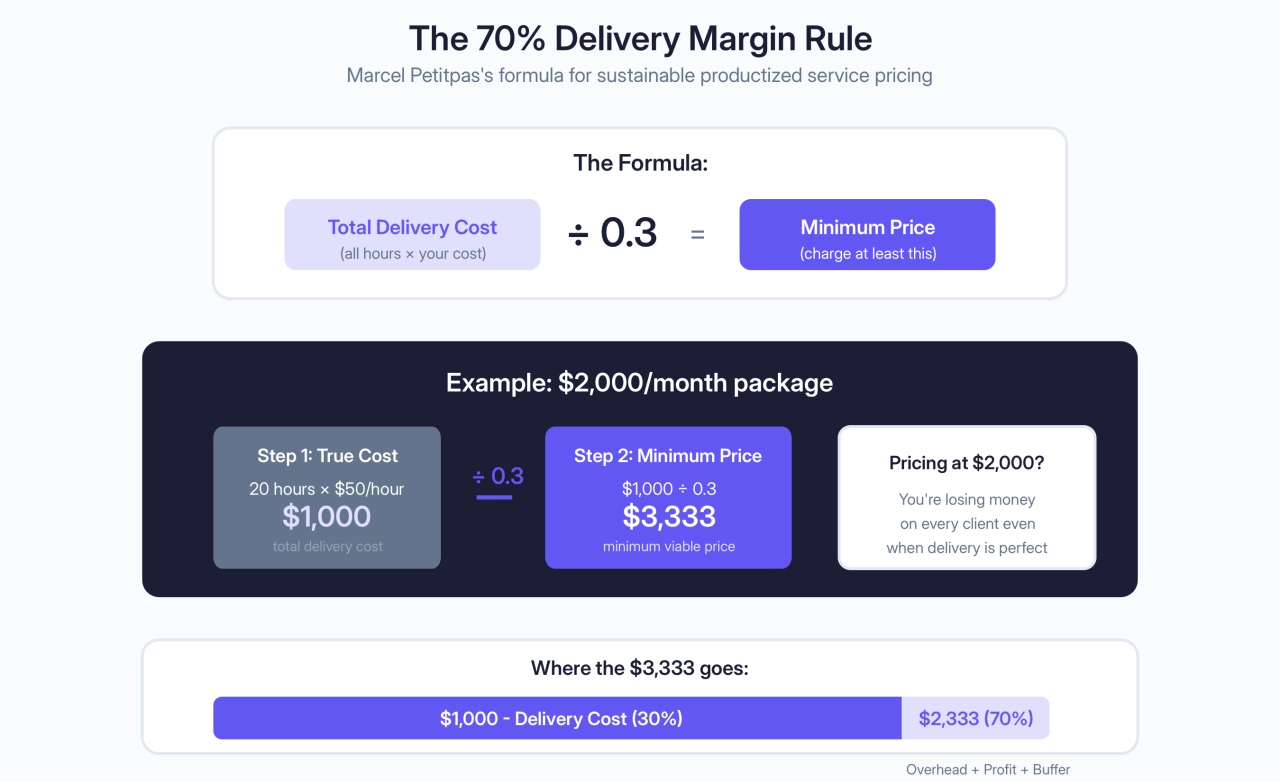
Build a true cost model and implement tracking from day one. Track actual delivery hours for 3–5 projects, including all the hidden time: sales calls, onboarding, project management, client communication, revisions. Most founders discover they underestimated delivery time by 40–60%. Include both variable costs (direct labor) and fixed overhead allocation per hour, just like Kontra discovered they needed to do. Don’t wait years to discover which clients are profitable—use project management tools that connect time tracking to financial analysis, so you can see true profitability per client in real-time.
Price based on the ROI your service delivers, not your costs. If your $3,000 SEO package generates $30,000 in additional revenue for clients, you’re positioned as a 10x return. This value-based pricing approach justifies premium pricing and shifts the conversation from cost to value—which matters when you’re trying to escape the race to the bottom.
Pitfall #6: cash flow gaps during transition
You’re excited about your new productized service. You scale back custom work to focus on it. The productized service is priced at $2,500 versus your old $10,000 projects. You need four new clients to replace one old one—but sales cycles for the new model are longer than expected. Month two hits: you’re $20,000 short on revenue with payroll due in five days.
Business impact: The typical transition creates a 2–4 month revenue valley. Custom projects wind down before productized volume scales up. If your productized service is 20–40% of your previous project values, you need 3-5x more clients to hit the same revenue—which takes time to build. One missed payroll and you’ve lost your best people. Miss two months of rent and you’re explaining gaps to future landlords.
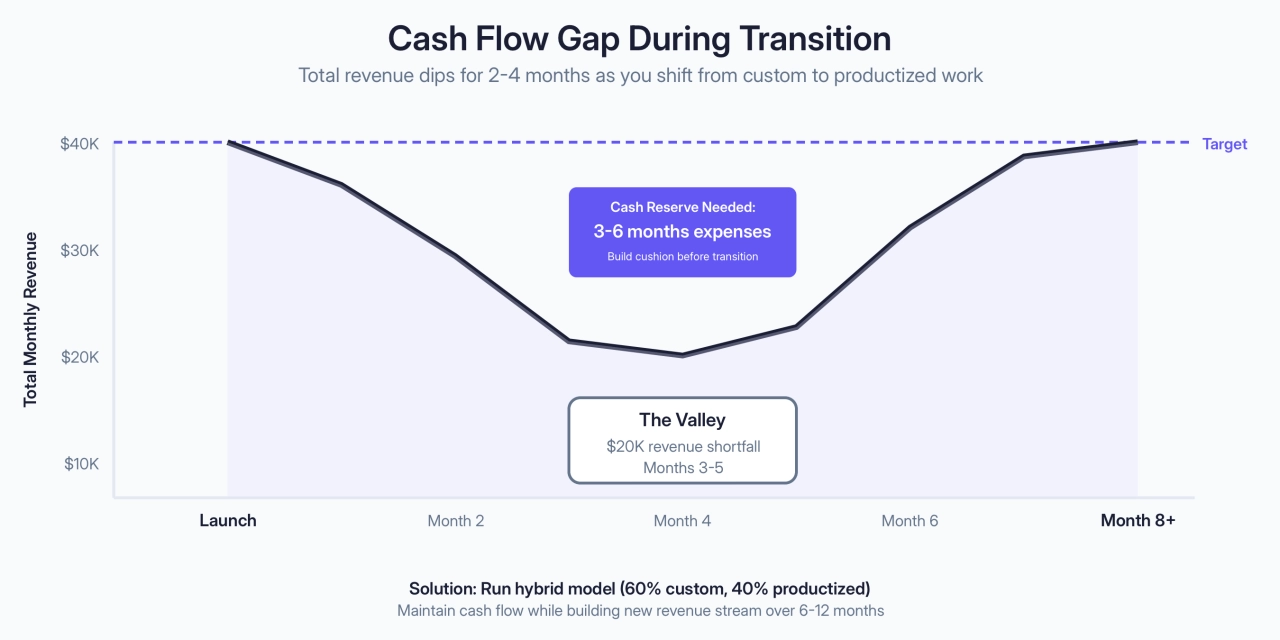
Real example from Caitlin Copple (Full Swing PR): Caitlin and her business partner Holly built Full Swing PR from $136,000 in year one to over $1 million by year four. The growth looked impressive from the outside, but Caitlin describes the reality in episode 91 of The Nathan Barry Show: “While it’s all great to make a million dollars, you can also spend $900,000. And that’s not really a viable business.”
The cash flow challenges hit repeatedly during their scaling journey:
clients not paying on time created immediate crises
they cut their own salaries many times to keep the team afloat
they operated without a business line of credit until year six
a constant seesaw between sales and delivery meant revenue was unpredictable
There’s been a lot of cash flow hiccups along the way. We’ve definitely had some moments where people don’t pay us. And that’s hard. And you pull every lever that you can to keep things moving.
 Caitlin Copple,
Full Swing PR
Caitlin Copple,
Full Swing PR
The core problem: Caitlin was getting pulled into delivery work, which killed sales momentum. When she focused on sales, delivery suffered. This teeter-totter dynamic meant revenue would climb, then plateau, then climb again—creating the cash flow instability that forced them to cut their own pay just to make payroll.
How to prevent this: Run a hybrid model for 6–12 months. Reserve 60–70% capacity for existing custom clients while dedicating 30–40% to productized development. This maintains cash flow while building the new revenue stream. The agencies that successfully transition do it gradually, not cold turkey.
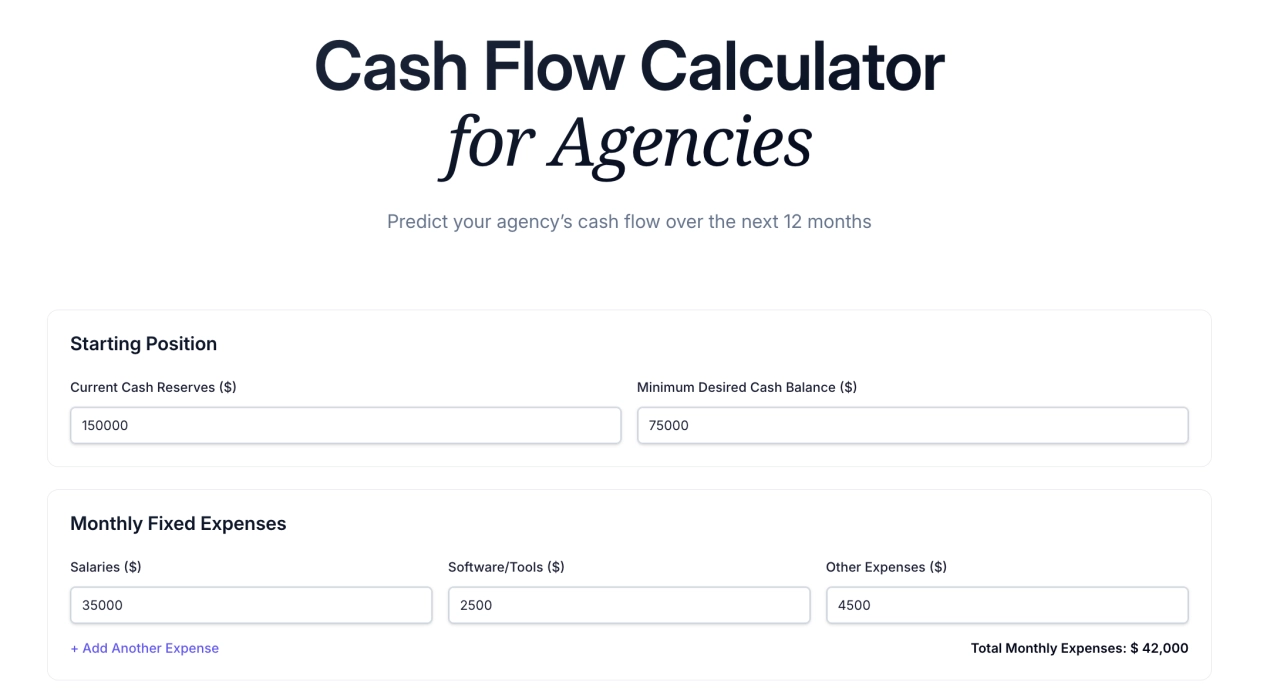
Predict your agency’s cash flow
Build a 3–6 month cash reserve before launching. Calculate your monthly operating expenses and multiply by 3–6. This is your transition cushion. If you’re at $30,000/month expenses, you need $90,000–$180,000 in reserves before going all-in on productization.
Require upfront payment for productized services. This eliminates accounts receivable entirely and immediately improves cash flow. For higher-priced offerings ($5,000+), use 50% upfront and 50% at delivery—but never start work without the initial payment clearing.
Client & legal challenges
These mistakes destroy client relationships and create expensive legal problems. Mediation costs $7,000 on average and takes 3–6 months. Litigation runs $91,000 and 1–3 years. The difference comes down to whether you protected yourself contractually before things went sideways—not how reasonable everyone seemed during the sales process.
Pitfall #7: clients expect unlimited revisions on fixed packages
You sell a fixed-scope, fixed-price Brand Identity Package for $5,000. Includes: logo, color palette, two brand guidelines pages. Client assumes it works like your old custom projects: unlimited revisions, phone calls whenever they want, you’ll just handle whatever comes up. By revision five, you’ve spent 30 hours on a project you scoped for 12. Your profit just disappeared.
Business impact: According to PMI’s Pulse of the Profession, 52% of projects experience scope creep, with affected projects seeing an average 27% cost overrun. For productized services, this manifests as revision cycles that never end, support requests that exceed boundaries, and delivery timelines that stretch from 2 weeks to 6 weeks. One agency tracked this: average project margin dropped from 65% to 32% when they didn’t enforce revision limits.
Real example from Brett Williams (Designjoy): Brett built Designjoy into a $1 million+ annual business with a subscription-based design service. But before creating his streamlined productized model, Brett experienced firsthand what happens when clients treat fixed offerings like unlimited custom services.
Working as a freelancer early in his career, Brett faced the classic expectation gap struggles:
clients demanding endless revisions without additional compensation
projects ballooning out of scope with no boundaries
unpredictable income cycles as timelines stretched indefinitely
constant exhaustion from clients who expected unlimited access
I was doing everything right, but it felt wrong. I was working harder, not smarter—and I knew I couldn’t keep going like that forever.
 Brett Williams,
Designjoy
Brett Williams,
Designjoy
The core problem wasn’t the work itself—it was the lack of clear boundaries. Clients operated under traditional service expectations (unlimited revisions, constant availability, flexible scope) while Brett was trying to deliver in a productized model. The mismatch destroyed his margins and nearly burned him out entirely.
His solution with Designjoy became a masterclass in setting boundaries: Clear boundaries with clients became foundational to his model. By working on one task at a time and establishing explicit systems for how clients submit requests and receive deliverables, Brett eliminated scope creep entirely. Clients understood the system upfront, which prevented the expectation gap that plagued his earlier freelance work.
Today, Designjoy’s success proves that productized services work—but only when expectations are crystal clear from day one.
How to prevent this: Define revision policy explicitly in three places: sales page, service agreement, and project kickoff email. Use clear language: “Includes two rounds of revisions within the defined scope. Additional revisions: $500 per round.” This isn’t harsh—it’s professional boundaries that protect both parties.
Create a change order process for out-of-scope requests. When clients ask for extras, pause work and send a formal change order: “This falls outside the package scope. Here’s what it costs and how it affects timeline. Please approve before we proceed.”
Build revision limits into your project management system. When client submits revision three, the system automatically triggers a message: “You’ve used your included revisions. Would you like to add revision round three for $500?”
Pitfall #8: skipping contracts costs $50,000+
You’re excited about your first few productized clients. Contracts feel like they'll slow down the sales process, so you work off a simple one-page agreement—or worse, just an email thread and a Stripe invoice. The problem is that productized services need different legal infrastructure than traditional agencies—standardized terms that every client accepts, not custom contracts negotiated per deal. Imagine six months in, a client claims you agreed to include social media management (you didn’t). They refuse final payment and threaten to leave negative reviews. Legal mediation costs you $8,000 and 40 hours of your time.
Business impact: Business disputes resolved through mediation average $7,000–$10,000 and take 3-6 months. Arbitration runs $10,000–$15,000. Full litigation? $91,000 on average and 1–3 years. According to the American Bar Association, 70–80% of business disputes that go to mediation could have been prevented with proper contracts upfront. Legal fees aside, founder time lost to disputes represents 15–30% of quarterly revenue in opportunity cost.
Real example from Nemanja Aleksic (ManageWP): Nemanja, who would later become Head of Growth at ManageWP, learned the hard way what happens when you skip proper contracts. Early in his career, a friend asked him to team up on a web development project. The money was good, and his friend vouched for the client: “They were great both as people and as professionals.”
I was young, dumb, and the money was good.
 Nemanja Aleksic,
ManageWP
Nemanja Aleksic,
ManageWP
The first mistake? Letting his friend handle project management with “a lot of face to face meetings with the company, but there was no paper trail and no contract.”
The project dragged on for months. Fundamental requirements still weren’t determined—no copy, no finalized structure. Then Nemanja received an email from the CEO asking why completion was taking so long.
The nightmare escalated from there:
First, unexpected scope creep: The CEO casually mentioned multilingual support. Nemanja and his friend had no idea what she was talking about—this was never part of the agreed scope. But without a contract defining what was included, they had no documentation to reference.
Then, the financial gut punch: The CEO dropped the bomb: “This is taking way too long, and with the new website being delayed, we’re taking a financial hit so we’ll have to cut the budget by 30%.”
Think about that. The client unilaterally:
Added major features (multilingual support)
Blamed the developers for delays caused by their own missing materials
Cut the payment by 30% with no negotiation
Nemanja and his friend ended up walking away from the project entirely. No payment. Months of work gone. The only silver lining? The lesson learned.
The cost of that missing contract? Not just the lost revenue from the project itself, but months of wasted time, damaged relationships, and the stress of having zero legal recourse when the client changed terms unilaterally.
How to prevent this: Invest in proper service agreements before launch. Budget $2,000-$5,000 for a business attorney to create templates covering: scope definition, payment terms, revision policy, intellectual property ownership, liability limitations, and dispute resolution process. This one-time investment prevents $50,000+ problems later.
Include two essential clauses in every contract: IP ownership and dispute resolution. Specify when the client owns the work—typically “Client receives full ownership rights upon final payment.” This protects your leverage if payment disputes arise. Add mandatory mediation language: “Any disputes will first be submitted to mediation per American Arbitration Association rules.” This saves both parties $50,000–$80,000 in legal costs if problems arise and creates a path to reasonable resolution.
Use escrowed milestone payments for projects over $5,000. Services like Escrow.com hold funds and release them upon deliverable approval. This protects both parties and eliminates most payment disputes before they start.
Finally, let’s look at how to prevent each of these pitfalls before launch. The checklist below ties back to the core principles of productized business models—standardization, validation, and systems that scale. If you can check all eight boxes, you’re ready.
Your pre-launch risk mitigation checklist
Before launch, work through these eight checkpoints. Each one prevents a specific expensive mistake. You don’t need perfection—you need to catch the problems that kill productized services in year one.
Checkpoint | Why It Matters | Prevents |
|---|---|---|
Validate demand with 10-15 customer interviews | Ask if they’d buy your specific offer at your specific price. Don’t pitch—learn. Agencies that skip this waste months building products nobody wants. | Pitfall #1: Misjudging market need |
Apply the aspirin vs vitamin test | If prospects aren’t urgently feeling pain right now, you’ll struggle. Tom Whatley’s digital PR service had high churn because clients saw it as nice to have. Ask: what expensive problem does this solve? | Pitfall #2: Productizing your passion project |
Build a true cost model from 3-5 pilots | Track every hour: client work, communication, revisions, PM. Marcel Petitpas found agencies discovering “if everything goes perfectly, you’ll only make 14% when you wanted 20%.” | Pitfall #5: Pricing trap |
Apply the 70% delivery margin rule | Take total delivery cost, divide by 0.3 to get minimum price. If it costs $1,000 to deliver, charge at least $3,333 (Marcel’s benchmark for sustainable margins). | Pitfall #5: Pricing trap |
Document “What’s not included” | 52% of projects experience scope creep with 27% average cost overruns (PMI). Make boundaries as prominent as deliverables in sales page and agreement. | Pitfall #3: Customization creepPitfall #7: Scope creep expectations |
Build automated onboarding systems | Manual intake limits growth to 4-6 clients/month. Automated forms + access request tools (like Leadsie) reduce onboarding from 1-2 weeks to minutes. | Pitfall #4: Onboarding bottlenecks |
Get attorney-drafted service agreements | Disputes cost $7,000-$10,000 (mediation) or $91,000 (litigation). The $2,000-$5,000 for proper contracts covering scope, payments, revisions, IP, and dispute resolution is cheap insurance. | Pitfall #8: Missing legal protection |
Build 3-6 month cash reserve | Calculate monthly operating expenses × 3-6. This cushions the transition period when custom work winds down before productized volume scales up. | Pitfall #6: Cash flow gaps |
Simple benchmark: If you can’t check all eight boxes, you’re not ready to launch. Each unchecked item represents a documented failure mode that’s cost agencies tens of thousands of dollars.
Frequently asked questions
What’s the biggest reason productized services fail?
Market validation failure. Agencies build what they want to deliver instead of what clients urgently need to buy. The benchmark data shows that agencies at 25–32% margins validated demand with 10-15 customer interviews before building, while those at 18–22% built first and hoped for sales later.
How do you handle custom requests without breaking your standardized model?
Create an explicit what’s not included list as prominent as your deliverables. When clients request extras, offer them as fixed-price add-ons (e.g., Competitor Analysis: +$500/month) or as separate custom projects with their own scope and pricing.
How do you transition existing clients to a productized model?
Consider keeping your top 3–5 custom clients indefinitely—the data shows 8-figure agencies maintain 92% retention by running hybrid models. Our guide on transitioning existing clients covers the full timeline and communication templates.
When should you not productize a service?
Services requiring deep ongoing collaboration don’t fit rigid productized boxes, according to Dav Nash. Productized consulting offers a middle ground—standardize the process, not necessarily the deliverable.
How long does it take to transition to a productized model?
Plan for 6–12 months running a hybrid model. Reserve 60–70% capacity for existing custom work while dedicating 30–40% to productized development. The agencies that transitioned successfully maintained cash flow through existing clients while building new revenue streams—they didn’t go cold turkey.
What this actually takes
Most agencies think the hard part is building the offer. It’s not. The hard part is anticipating what breaks at scale—before you’re drowning in margin erosion and cash flow gaps.
Run through the checklist. Talk to customers before you build. Price for the margins you actually need, not what feels competitive. Get proper contracts before you need them. Then follow the implementation playbook that takes you from validation to launch.
The agencies that make this work aren’t smarter—they just did the boring operational work upfront instead of learning these lessons at $91,000 per mistake.










